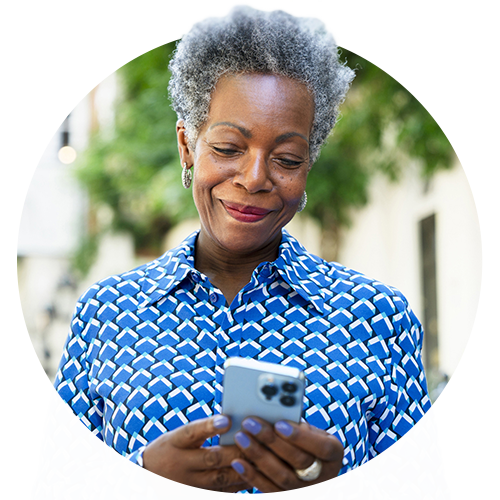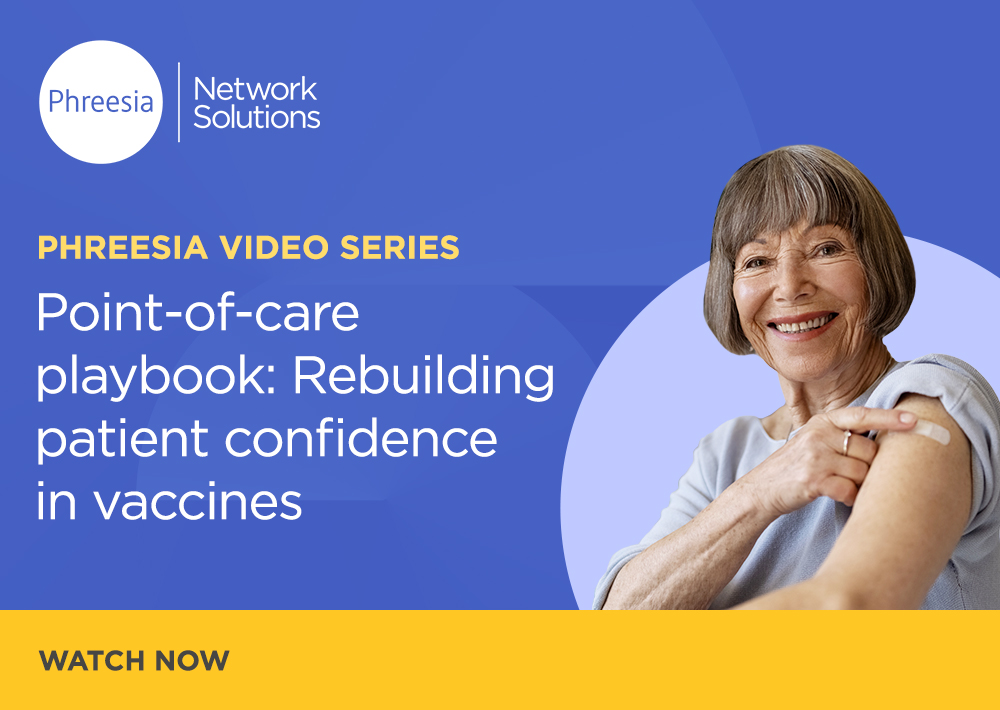
Older adults are using technology more than ever, making the digital messaging at the point of care the ideal place to reach them with health information.
For government and public health agencies focused on improving outcomes for older adults, effective communication is everything. The right message can help support prevention, early detection and more informed healthcare decisions. However, traditional outreach methods like television ads, billboards, mailers and brochures rarely deliver the results needed. This type of outreach relies on memory and delayed action, hoping the individual will remember to follow up later. Further, traditional outreach tends to deliver one-size-fits-all messages that aren’t tailored to each individual’s specific health needs. For older adults managing multiple responsibilities, chronic health conditions or cognitive limitations, that’s a tall order.
Education delivered at the point of care changes that. At the point of care, when they’re checking in for a medical visit, older adults are actively thinking about their health and healthcare. Receiving messaging that is timely, specific and aligned with an upcoming or recent appointment creates a sense of urgency and relevance that encourages follow through. Oftentimes, it also prompts the kinds of conversations with providers that lead to informed decision making.
As public health agencies look to expand the reach and impact of their campaigns, it’s time to consider how to leverage the point of care to engage older adults.
Older adults are more digitally engaged than you think
The assumption that older adults shy away from technology is outdated. The truth is, older adults are not only capable of using technology—they’re actively embracing it. According to the Pew Research Center, 75% of Americans aged 65 and older now use the internet, and more than 60% own a smartphone. The pandemic only accelerated this trend, making digital healthcare tools mainstream for many older patients.
At Phreesia, we see firsthand how older adults are integrating digital health tools into their care routines. Take a look at the results from Phreesia’s survey of more than 4,000 patients:
- Online check in: When it comes to online check in, 55% of adults aged 65 and older said they prefer to see doctors that offer online check in, citing speed (54%), convenience (57%) and less time spent in the waiting room (62%) as their top value drivers.
- Online scheduling: More than two-thirds of Phreesia-surveyed patients aged 65 and older said they would like to schedule or reschedule appointments online.
- Digital messaging: Among patients aged 65 and older, 75% said they enjoy using digital messaging, such as emails, text messages and patient portals, to communicate with their providers.
Web-based tools, like secure links on personal devices, offer broader accessibility without requiring installation, which may be especially beneficial for older adults who may be less comfortable downloading and managing healthcare apps on their phone.
This shift presents a valuable opportunity for government agencies, life sciences organizations, advocacy groups and other entities to reimagine patient education, especially at one of the most impactful touchpoints: the point of care. Here’s why.
1 | The point of care is a uniquely powerful moment for education
For older adults, healthcare visits are more than occasional check ins—they’re regular touchpoints in receiving healthy lifestyle guidance and for managing chronic conditions. At the point of care, patients are already focused on their health and the decisions that need to be made. Digital education delivered right before, during or immediately after a visit can drive action because it is timely. When the messaging is tailored to the individual’s specific health needs, and easy to understand, it can be even more impactful.
Why timing matters:
- Proximity to action: Patients can apply the education right away—before, during or immediately after their visit.
- Health is top of mind: At the point of care, older adults are already thinking about their health needs and decisions that will impact their care and outcomes going forward. This makes them far more open to receiving and acting on educational content than in other settings.
- Better retention: Information tied to a real-time medical need is more likely to be remembered and applied.
“When we meet older adults with the right information at the right moment—especially right before or after a healthcare visit—we empower them to make informed decisions,” says Kelsey Pratt, Director of Market Development at Phreesia. “For healthcare agencies and organizations, that’s not just education. That’s patient empowerment in action.”
2 | The clinical setting builds trust and amplifies impact
Older adults are discerning about where they get their health information, and for good reasons. In an age of information overload, trust is everything. Fortunately, the clinical environment is one of the few places where that trust still runs deep.
According to a 2025 Gallup poll, medical professionals consistently rank among the most trusted professions in the United States. For older adults specifically, a recommendation or message delivered in the context of a provider or pharmacy visit carries far more weight than something seen on a website or in a television commercial.
Here’s how the care setting amplifies impact:
- Built-in authority: Information shared within a clinical environment is seen as vetted and credible.
- Provider alignment: When digital education aligns with provider guidance, it reinforces key messages and drives clarity.
- Follow through is easy: Whether it’s seeking healthy eating tips, scheduling a test, adjusting a medication or asking a question, the infrastructure for action is already in place.
3 | Education equips older adults to navigate healthcare decisions with confidence
Older adults are more likely than any other age group to be managing chronic conditions, and the gaps in their care are well-documented. According to the National Council on Aging, nearly 95% of older adults have at least one chronic condition, and nearly 80% have two or more. These conditions require constant attention, adherence to complex care plans and regular engagement with the healthcare system.
Despite this, many older adults still miss out on preventive screenings, struggle to adhere to medications and treatment plans, and have trouble with lifestyle modifications, such as nutrition, exercise and smoking cessation. Digital education at the point of care can foster more meaningful patient–provider conversations and support better clinical outcomes by offering timely information about:
- Chronic disease management
- Healthy living and lifestyle changes
- Fall prevention and home safety
- Health checks, screenings and lab tests
- Medication adherence reminders and tools
“Empowered with this knowledge, older adults can have more meaningful conversations with their providers and make better-informed decisions about their health needs,” Pratt says.
Beyond clinical care, older adults often navigate a complex healthcare landscape with limited support. Digital education can also equip them to make more informed decisions about their health coverage and financial protections by offering resources to better understand:
- Medicare Advantage benefits
- Medical fraud scams or warning signs
- Patient assistance programs
- Coverage options and enrollment help
“Messaging at the point of care reduces friction and makes it easier for patients to consider and act upon their healthcare needs,” Pratt adds.
For example, campaigns on Phreesia’s PatientConnect platform have helped older adults in several ways:
- Among adults aged 65 and older, 70% said the vaccine content they received on the platform was helpful, with nearly half rating it as very or extremely helpful.
- After viewing a campaign about heart health, 53% of adults aged 65 and older said they were likely to talk to their doctor about heart disease risks and prevention.
- When it came to information about a Medicare financial assistance program for medications, 7 in 10 patients aged 65 and older found the content helpful.
- After viewing a campaign, 58% of adults over 65 said they are likely to search for more information about a Medicare financial assistance program, and 51% indicated they are likely to enroll.
- In a ‘New to Medicare (Turning 65)’ campaign, 49% of participants found the information helpful, and 50% of patients indicated they are very likely to seek additional information.
These campaigns show that the point of care is a critical opportunity for healthcare agencies and organizations to engage patients. By aligning educational outreach with their expectations and behaviors, organizations can meet older adults where they are and support them in making decisions that could lead to better health.
Whether developing disease awareness campaigns, promoting preventive screenings and diagnostic tests, offering information on new medications or treatments, or providing education about Medicare benefits, digital point-of-care education should be a key part of your strategy.
The tools are here. The audience is ready. The only question left: Are you? Learn how Phreesia can help you reach older adults at the point of care.


